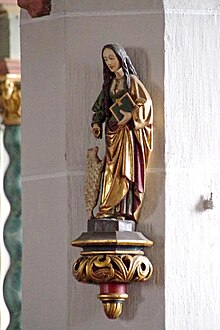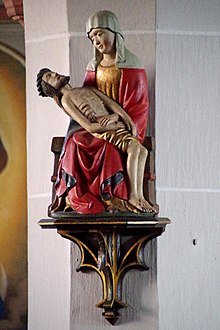St. Kunibert (Sinzenich)
St. Kunibert in Sinzenich , a district of Zülpich , is a very remarkable and peculiar Roman Catholic church in the northern Eifel foothills . The deviations from the usual forms of construction can be explained by the fact that the Roman stock was retained. The church is the only partially preserved Roman building between Cologne and Trier . It testifies that the early Christians used Roman buildings as churches . Roman masonry is preserved in the choir arch wall and in the western tower wall up to nine meters high, in the narrow sides of the tower up to five meters and in the east wall three meters high and can be seen in part.
history
A roof truss was erected on the foundations of the Roman villa around 1031 , so that it can be said that the Roman building served as Sinzenich's church from this year at the latest. The transverse rectangular tower was built around 1200 on Roman walls. The square choir , angled slightly to the east, dates from the first half of the 13th century. The sacristy is a small extension to the 14th century and was formerly the northern aisle as a sanctuary . The nave was rebuilt around 1500 . The oratory on the southwest side was added for Franciscan nuns at the beginning of the 16th century . In 1964 the church received its organ . It is a work of the Verschueren company from the Netherlands . St. Kunibert has been a listed building since May 19, 1987 .
Furnishing
The last major restoration of the church interior took place in 1982/83 under Pastor Wilhelm Cornelissen with the architect KJ Ernst from Zülpich. The masonry altar hall dates from the time the choir was built. The vault paintings of the choir were created around 1500. Filigree branches of flowers surround the four Evangelist medallions in the vault caps . Remnants of figurative medieval wall paintings are still preserved in the basement of the tower area. The wooden sculpture of Saint Agnes was made around 1500 and was later polychromed . The white lamb leaping up on her right hand is a symbol of the heavenly bridegroom. The wooden Pietà is from the early 15th century. The wooden figure of Judas Thaddäus also dates from this time . The polychrome wood sculpture of the patron saint Kunibert is a work from around 1700. The main altar, the sacrament house and the eternal light were designed by J. Wolks from Waldfeucht in 1904. The two side altars are rough works of the later 17th century with twisted columns and cartilage ornaments. In 1861 the Düsseldorf artist Busch painted new paintings in the Nazarene style for both altars . Saint Catherine is depicted in the south aisle and the Mother of God in a praying posture in the north aisle . The marble baptismal font from 1841 stands in a tower yoke. The body of the altar cross was created by Coerner from Bad Münstereifel in around 1730. Eight church windows from the Dr. Oidtmann from Linnich were deployed in 1966. The Monstrance is a work by the master goldsmith Gerhard Bucking from the second half of the 16th century with stylistic elements from the transition from the late Gothic to the Renaissance . St. Kunibert has four old bells . The two larger ones are from 1506, the third bell is from 1774 and the smallest from 1588.
literature
Dorothea Eimert: St. Kunibert Sinzenich, Schnell Art Guide No. 1695, 1st edition, Verlag Schnell & Steiner GmbH, Munich and Zurich, 1988



